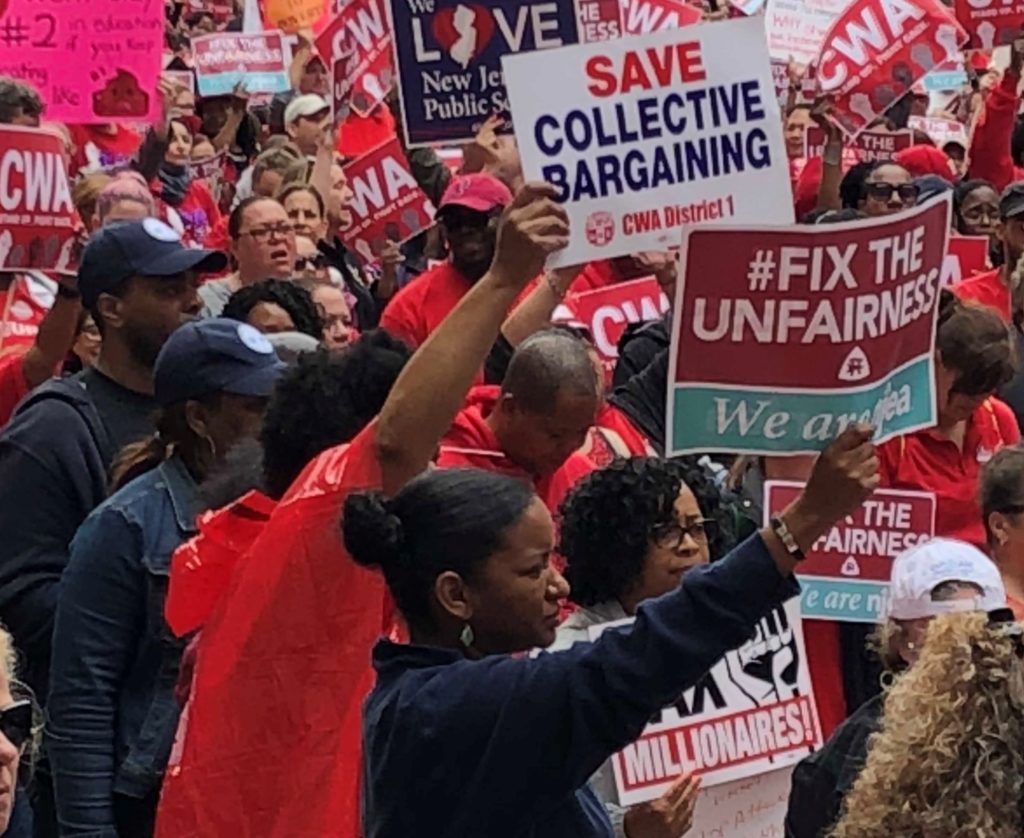Just Who is Essential in NJ's COVID-19 Battle?

NJ’s CWA FIGHTS FOR WORKER SAFETY AND THE PUBLIC HEALTH
Response depends on zip code
In just a matter of a week the state of New Jersey has had to put itself on a wartime footing in hopes of defeating the invisible, yet deadly coronavirus that’s claimed thousands of lives around the world including dozens in the region.
Here in New Jersey, and throughout the country, the unions representing the essential workforce fighting pandemic are playing a pivotal role in working to keep their workers safe as they put themselves and their families at risk to safeguard the public health.
Hetty Rosenstein is president of Communication Worker of America New Jersey, which represents 65,000 workers at state agencies as well as with county and municipal governments.
A MUCH BIGGER UNIVERSE
While the media frames essential workers as the physicians, nurses and first responders like fire and police, the reality is, Rosenstein notes, there are a myriad of other public and private sector jobs that are also essential to keeping society functioning in the midst of the current pandemic.
“The essential workforce is pretty broad,” she said. “At the Board of Health there is the 24-hour hotline, obviously the Department of Children and Families and those hotline screeners, it’s always the hotlines on things like child abuse.”
“So, we also have the people that handle child neglect and foster care where you have to make arrangements for children in foster care,” Rosenstein said. “And now in cases where children are required to see their parents twice a month, they have to do it through FaceTime now.”.
NJ’S 24-7 OBLIGATIONS
CWA of New Jersey also represents workers that staff the state’s s 24-7 residential care facilities and corrections system.
“In these 24-7 state institutions like our psychiatric and development centers we have everyone from the doctors, the nurses, the cottage training people and the food services folks as well,” she said. “In corrections we represent all the teachers, nurses, doctors and psychologists, librarians, and clerical workers.”
Rosenstein said agencies have to maintain the service required informed by the risks that are quickly evolving as they try to accommodate workers facing challenges like finding childcare, now an issue with local schools closed.
“Human Services has really stepped up to the challenges involving children and families where they are trying to figure out every option for people to work from home but at the same time have to meet a really critical function so like they want to help figure out how people can find child care,” Rosenstein said. “Here we do have a huge problem.”
She continued. “Essential workers have their kids at home from school, so they need childcare and essential workers also need equipment they don’t necessarily have like personal protective equipment like masks and gloves.”
SOLID AT THE TOP
The CWA leader had high praise for how Gov. Phil Murphy and his administration were handling what is a very dynamic situation where the state’s guidance daily to reflect the evolving public health facts on the ground.
Governor Phil Murphy has been consistent in his public messaging on the state’s efforts to use social distancing to avoid what happened in northern Italy when its health care system was overwhelmed by the coronavirus.
On March 16, Murphy, working in close coordination with Governor Andrew Cuomo, suggested that all of New Jersey’s residents not go out between 8 p.m. to 5 a.m. for any non-essential travel.
“It is not a curfew per se,” Murphy told MSNBC’s Steve Kornacki. “It is a strong---passionate recommendation for the foreseeable future. We’ve got to flatten the curve at all cost---break the back of this right now, and if we succeed take the pressure off of the health care system and God willing save some lives as a result.”
The concept of social distancing requires individuals not congregate in groups of ten or larger and that people make an effort to stay six feet apart to avoid transmission of the deadly virus.
‘NOT THAT BAD HERE’
“It is harder at the county and municipal level to get this implemented,” Rosenstein said. “They are not getting the same leadership from the Governor and some of the counties are not as serious about this perhaps in part, because they have less of the virus, for right now.”
She continued. “At the county level it is really a crap shoot. Take the Union County Board of Social Services that stepped up immediately and said, ‘let’s make sure we get as much of the public out of the crowded waiting rooms as possible and that we are only dealing with emergency cases.’”
In another case, Rosenstein said union officials clashed with the lawyer representing a county that resisted the imposition of social distancing or pandemic mitigation because they said the county’s infection rate was still relatively low.
LEAVING NOBODY BEHIND
The CWA is also tracking the health care insurance status of 10,000 to 12,000 people that work for state and local agencies as temps and part-timers.
Even as the union is attempting to get local government managers to uniformly adopt Gov. Murphy’s coronavirus guidance, they have to be vigilant about their own risk of succumbing to the virus.
“So, with our national union, people are working from home whenever possible and there are circumstances where people will still go out if they absolutely have to, but we have canceled and postponed everything we can,” she said. “But many of our local offices are still working in their offices because their members are working.”






are landscapers essential